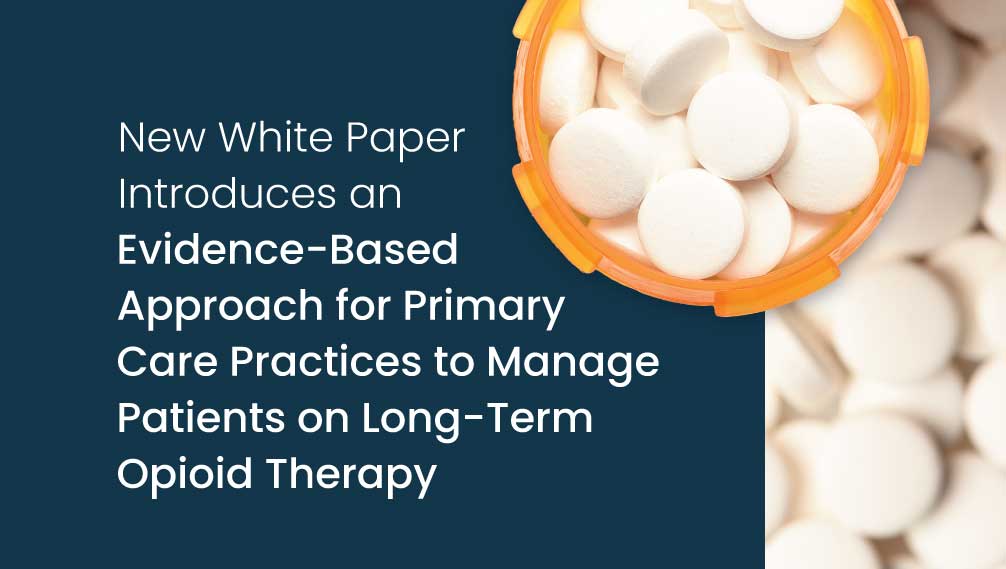Improving Opioid Management in Primary Care
The number of overdose deaths involving opioids – including prescription opioids, heroin, and synthetic opioids–continues to climb every year. In 1999, the total number of overdose deaths was 16,849; in 2021, it was 106,699, a nearly six-fold increase. Yet there hasn’t been an overall change in the amount of pain reported by Americans.

Learn more about the evidence-based Opioid Management Program, and read our latest white paper:
Who Is at Risk for Opioid Abuse?
Anyone who uses opioids for pain management is at risk for overdose. An estimated 20.9% of U.S. adults (51.6 million) said they experienced chronic pain in 2021, and 6.9% reported experiencing high-impact chronic pain that significantly restricts their daily activities. A study published in JAMA Surgery in 2017 found that 5.9% to 6.5% of U.S. patients adopted and continued to use opioids 90 days after minor or major surgical procedures, making chronic pain opioid use one of the most common post-surgical complications.
Who Is at Risk for Opioid Abuse?
Anyone who uses opioids for pain management is at risk for overdose. An estimated 20.9% of U.S. adults (51.6 million) said they experienced chronic pain in 2021, and 6.9% reported experiencing high-impact chronic pain that significantly restricts their daily activities. A study published in JAMA Surgery in 2017 found that 5.9% to 6.5% of U.S. patients adopted and continued to use opioids 90 days after minor or major surgical procedures, making chronic pain opioid use one of the most common post-surgical complications.
Opioid Prescribing Rates and Patterns
The overall U.S. opioid dispensing rate in 2020 was 43.3 prescriptions per 100 persons, down from the peak in 2012 of 81.3 prescriptions per 100. The dispensing rate varies significantly across the country, ranging from a low of 27.3 in Hawaii to a high of 80.4 in Alabama in 2020. Prescription opioids were involved in nearly 18% of opioid overdose deaths in the U.S. that year. Primary care providers account for nearly half of all dispensed opioid prescriptions, and their prescribing rates have increased at high rates compared to other specialties, according to the CDC. In contrast, the CDC recommends prescribing no greater quantity than needed for the expected duration of pain severe enough to require opioids.
Potential Benefits of Improving Long-Term Opioid Therapy Management
Taking prescription opioids for longer periods or in higher dosages can increase the risk of opioid addiction, overdose, and death. And a growing body of evidence demonstrates that long-term opioid therapy is not effective for chronic pain. Improving long-term opioid therapy management provides three key potential benefits:
- Improved patient safety and quality of care: Reduced risk of patient overdose and addiction
- Reduced hospital readmissions and ED utilization: Increased focus on proactively managing high-risk patients, including regular follow-up visits and services, which can result in lower avoidable ED utilization and inpatient hospitalization rates
- Increased revenue opportunities: Additional opportunities for primary care providers to provide and bill for Medicare-covered care management services for patients with substance abuse diagnoses, including chronic care management (CCM) and complex CCM services
Opioid Management in Primary Care: The Six Building Blocks Program
The Six Building Blocks Program is a quality improvement roadmap that helps primary care practices and clinics implement consistent, patient-centered, evidence-based care for chronic pain patients on long-term opioid therapy.
The program was developed by the University of Washington Department of Family Medicine and the Kaiser Permanence Washington Health Research Institute with federal and state funding support. The clinician-led team at Stroudwater Associates worked closely with these two organizations to become practice facilitators of the Six Building Blocks Program. Adoption of the program was included in implementation package for the 2016 and 2022 CDC guidelines for prescribing opioids for chronic pain.
To date, Stroudwater has worked with four hospitals in three states to implement the Six Building Blocks program. After the program was implemented, the number of patients on chronic opioid therapy and the proportion on high-dose opioids decreased.
As part of the Opioid Management Program, the Six Building Blocks program includes:
- Introductory presentations to orient administration and clinic staff to the program
- Data collection
- Implementation of an opioid improvement team with provider and clinic champions
- Clinic self-assessments completed by clinic staff to identify current gaps in opioid management
- Interviews with prescribing physicians/ providers, clinic support staff and administration
- In-depth surveys completed by clinic staff to better understand current chronic pain management and opioid management practices and processes within clinics at the individual physician/provider level
The program helps Stroudwater to identify quality improvement gaps and opportunities and offer recommendations for each clinic to implement changes and to improve opioid management and patient outcomes.
